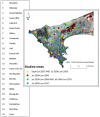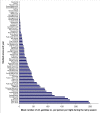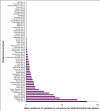Conditions of malaria transmission in Dakar from 2007 to 2010
- PMID: 22018223
- PMCID: PMC3216462
- DOI: 10.1186/1475-2875-10-312
Conditions of malaria transmission in Dakar from 2007 to 2010
Abstract
Background: Previous studies in Dakar have highlighted the spatial and temporal heterogeneity of Anopheles gambiae s.l. biting rates. In order to improve the knowledge of the determinants of malaria transmission in this city, the present study reports the results of an extensive entomological survey that was conducted in 45 areas in Dakar from 2007 to 2010.
Methods: Water collections were monitored for the presence of anopheline larvae. Adult mosquitoes were sampled by human landing collection. Plasmodium falciparum circumsporozoïte (CSP) protein indexes were measured by ELISA (enzyme-linked immunosorbent assay), and the entomological inoculation rates were calculated.
Results: The presence of anopheline larvae were recorded in 1,015 out of 2,683 observations made from 325 water collections. A water pH of equal to or above 8.0, a water temperature that was equal to or above 30°C, the absence of larvivorous fishes, the wet season, the presence of surface vegetation, the persistence of water and location in a slightly urbanised area were significantly associated with the presence of anopheline larvae and/or with a higher density of anopheline larvae. Most of the larval habitats were observed in public areas, i.e., freely accessible. A total of 496,310 adult mosquitoes were caught during 3096 person-nights, and 44967 of these specimens were identified as An.gambiae s.l. The mean An. gambiae s.l. human-biting rate ranged from 0.1 to 248.9 bites per person per night during the rainy season. Anopheles arabiensis (93.14%), Anopheles melas (6.83%) and An. gambiae s.s. M form (0.03%) were the three members of the An. gambiae complex. Fifty-two An. arabiensis and two An. melas specimens were CSP-positive, and the annual CSP index was 0.64% in 2007, 0.09% in 2008-2009 and 0.12% in 2009-2010. In the studied areas, the average EIR ranged from 0 to 17.6 infected bites per person during the entire transmission season.
Conclusion: The spatial and temporal heterogeneity of An. gambiae s.l. larval density, adult human-biting rate (HBR) and malaria transmission in Dakar has been confirmed, and the environmental factors associated with this heterogeneity have been identified. These results pave the way for the creation of malaria risk maps and for a focused anti-vectorial control strategy.
Figures







References
-
- Keiser J, Utzinger J, Caldas de Castro M, Smith TA, Tanner M, Singer BH. Urbanization in sub-saharan Africa and implication for malaria control. Am J Trop Med Hyg. 2004;71:118–127. - PubMed
-
- UNPD. World Urbanization Prospects: the 2007 revision population database. 2007.
-
- Robert V, Macintyre K, Keating J, Trape JF, Duchemin JB, M W, Beier JC. Malaria transmission in urban sub-saharan Africa. Am J Trop Med Hyg. 2003;68:169–176. - PubMed
-
- Trape JF, Zoulani A. Malaria and urbanization in central Africa: the example of Brazzaville. Part II: Results of entomological surveys and epidemiological analysis. Trans R Soc Trop Med Hyg. 1987;81(Suppl 2):10–18. - PubMed
MeSH terms
Substances
LinkOut - more resources
Full Text Sources

